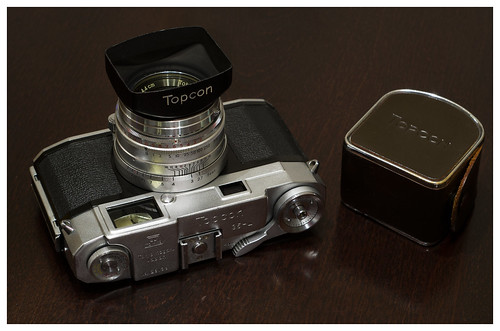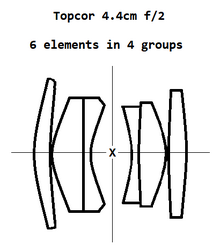No edit summary |
Helios 1984 (talk | contribs) m (grammar correction) Tag: Visual edit |
||
| (13 intermediate revisions by 2 users not shown) | |||
| Line 1: | Line 1: | ||
{{Flickr image|image_align = right|image_source = https://www.flickr.com/photos/89007582@N04/38078836424/in/dateposted-public/|image = https://c1.staticflickr.com/5/4564/38078836424_32b3a491cf.jpg|image_text = Topcon 35-L with square hood and |
{{Flickr image|image_align = right|image_source = https://www.flickr.com/photos/89007582@N04/38078836424/in/dateposted-public/|image = https://c1.staticflickr.com/5/4564/38078836424_32b3a491cf.jpg|image_text = Topcon 35-L with square hood and |
||
| − | carry case. Picture courtesy of Helios 1984.|image_rights = with permission}}The '''Topcon''' '''35-S''', |
+ | carry case. Picture courtesy of Helios 1984.|image_rights = with permission}}The '''Topcon''' '''35-S''', '''35-L''' and '''35-JL''' are [[35mm film|35mm]] fixed-lens [[Rangefinder camera|rangefinder]] cameras manufactured by [[Tōkyō Kōgaku]] from 1956 to late 1959 and successors of the [[Topcon 35]] series. |
<nowiki>*</nowiki> |
<nowiki>*</nowiki> |
||
| − | The '''Topcon''' '''35-S '''was released in 1956 and manufactured for about a year. It features a specifically designed ''Topcor 44mm f/2'' semi-wide angle and |
+ | The '''Topcon''' '''35-S '''was released in 1956 and manufactured for about a year. It features a specifically designed ''Topcor 44mm f/2'' semi-wide angle and a [[Seikosha-MX]] [[leaf shutter]] with speeds from 1 to 1/500 sec and B. The lens is a Double-Gauss type with 6 elements in 4 groups (1-2-2-1), same design as the Topcor-S 50mm f/2. It has an accessory shoe on the top cover and an MFX synchronized [[Flash sync|flash terminal]] located on the side of the lens housing. The viewfinder is an Albada-frameline type with automatic [[parallax]] correction with a 1:1 aspect ratio. Lastly, the advance mechanism is double-stroke which was claimed by Topcon to prevent the tearing of sprocket holes in films. At the time of its release, it was priced at [[Japanese prices|¥33,200]] ($109 in the U.S.A<ref>Popular Photography - April 1957 - Vol. 40, No. 4 - Page 164<br> |
</ref>.). |
</ref>.). |
||
| + | [[File:Topcor 4.4cm f2.png|thumb|252x252px]] |
||
<nowiki>**</nowiki> |
<nowiki>**</nowiki> |
||
| + | [[File:LV-0.PNG|thumb|220x220px]] |
||
| ⚫ | The '''Topcon''' '''35-L''' (Beseler Topcon-L in North America) replaced its predecessor in 1957. It was released just a few months before the Topcon R (Beseler B Topcon). Its specifications are the same as the 35-S, however, it was upgraded with a [[Seikosha-MXL]] [[leaf shutter]] which features the "new" [[Light-value system|LV system]]. It was sold together with a selenium light meter giving readings in '''Light Value''' and was priced at [[Japanese prices|¥35,000]]. |
||
| ⚫ | The '''Topcon''' '''35-L''' (Beseler Topcon-L in North America) replaced its predecessor in 1957 |
||
<nowiki>***</nowiki> |
<nowiki>***</nowiki> |
||
| − | The '''Topcon''' '''35-JL''' was released almost simultaneously with the |
+ | The '''Topcon''' '''35-JL''' was released almost simultaneously with the 35-L. It is identical to its sister camera but equipped with a Topcor 44mm f/2.8 and was slightly less expensive. The lens is an [[Heliar]] type with 5 elements in 3 groups (2-1-2), same design as the Topcor 50mm f/2.8. It was phased out in late 1959 together with the 35-L, marking the end of the 35mm rangefinders era at Topcon. |
<nowiki>****</nowiki> |
<nowiki>****</nowiki> |
||
Revision as of 01:06, 8 September 2019

|
| Topcon 35-L with square hood and
carry case. Picture courtesy of Helios 1984. (Image rights) |
The Topcon 35-S, 35-L and 35-JL are 35mm fixed-lens rangefinder cameras manufactured by Tōkyō Kōgaku from 1956 to late 1959 and successors of the Topcon 35 series.
*
The Topcon 35-S was released in 1956 and manufactured for about a year. It features a specifically designed Topcor 44mm f/2 semi-wide angle and a Seikosha-MX leaf shutter with speeds from 1 to 1/500 sec and B. The lens is a Double-Gauss type with 6 elements in 4 groups (1-2-2-1), same design as the Topcor-S 50mm f/2. It has an accessory shoe on the top cover and an MFX synchronized flash terminal located on the side of the lens housing. The viewfinder is an Albada-frameline type with automatic parallax correction with a 1:1 aspect ratio. Lastly, the advance mechanism is double-stroke which was claimed by Topcon to prevent the tearing of sprocket holes in films. At the time of its release, it was priced at ¥33,200 ($109 in the U.S.A[1].).

**

The Topcon 35-L (Beseler Topcon-L in North America) replaced its predecessor in 1957. It was released just a few months before the Topcon R (Beseler B Topcon). Its specifications are the same as the 35-S, however, it was upgraded with a Seikosha-MXL leaf shutter which features the "new" LV system. It was sold together with a selenium light meter giving readings in Light Value and was priced at ¥35,000.
***
The Topcon 35-JL was released almost simultaneously with the 35-L. It is identical to its sister camera but equipped with a Topcor 44mm f/2.8 and was slightly less expensive. The lens is an Heliar type with 5 elements in 3 groups (2-1-2), same design as the Topcor 50mm f/2.8. It was phased out in late 1959 together with the 35-L, marking the end of the 35mm rangefinders era at Topcon.
****
Size 132 x 79 x 64mm
Weight 720g
Filter size 40.5mm
Push-On lens cap size 42mm
Notes & References
- On the 35-L and 35-JL, the aperture ring click stops on full numbers when the shutter is set at B, 1sec, 1/2, 1/250 & 1/500 and click stops at half points between numbers when the shutter is set at 1/5, 1/10, 1/25, 1/50 & 1/100 for a better exposure. However, it is possible to set the aperture ring between click stops if needed. For more information concerning the light value scale and speed/aperture combination, read pages 22 to 25 of the manual.
- List of available accessories: Square hood, a leather case, a lens cap, shutter release button, a selection of filters (Y1, Y2, O2 & UV), reloadable cassettes for bulk film loading and an amplifier for the Topcon-Meter.
- The Topcon-Meter was made by Sekonic.
- Some Topcon 35-L and Topcon 35-JL have a modified Albada viewfinder with the edges of the window 100% silvered and a clear centre.
- The Topcon 35-S has 10 aperture blades.
- Both Topcon 35-L & Topcon 35-JL have 5 aperture blades.
- ↑ Popular Photography - April 1957 - Vol. 40, No. 4 - Page 164
Bibliography
- Antonetto, M. and Russo, C. Topcon Story. Lugano: Nassa Watch Gallery, 1997. ISBN 88-87161-00-3. P. 33.
- Asahi Camera (アサヒカメラ) editorial staff. Shōwa 10–40nen kōkoku ni miru kokusan kamera no rekishi (昭和10–40年広告にみる国産カメラの歴史, Japanese camera history as seen in advertisements, 1935–1965). Tokyo: Asahi Shinbunsha, 1994. ISBN 4-02-330312-7. Items 1368–70. (See also the picture on p. 485.)
- Lewis, Gordon, ed. The History of the Japanese Camera. Rochester, N.Y.: George Eastman House, International Museum of Photography & Film, 1991. ISBN 0-935398-17-1 (paper), ISBN 0-935398-16-3 (hard). P. 94.
- McKeown, James M. and Joan C. McKeown's Price Guide to Antique and Classic Cameras, 12th Edition, 2005-2006. USA, Centennial Photo Service, 2004. ISBN 0-931838-40-1 (hardcover). ISBN 0-931838-41-X (softcover). P. 925.
- Sugiyama, Kōichi (杉山浩一); Naoi, Hiroaki (直井浩明); Bullock, John R. The Collector's Guide to Japanese Cameras. 国産カメラ図鑑 (Kokusan kamera zukan). Tokyo: Asahi Sonorama, 1985. ISBN 4-257-03187-5. Items 3797–9.
Links
In English:
- Pages of Mike Butkus's site:
- Topcon 35-JL (Japanese version) at Cosmonet's Classic Camera site
- Topcon 35-L repair notes at kyphoto.com's Favorite Classics (If the link is broken, click here)
In Japanese:
- Topcon 35-L repair notes by Yoshiaki Taguchi at Kitamura Camera
- Pages of the Topcon Club website
- Page about various Topcon cameras, including the Topcon 35-S, L and JL
- Topcon 35-S leaflet
- Other Topcon 35-S leaflet
- Page 1 and page 2 of a Tōkyō Kōgaku catalogue dating about 1956, listing the Topcon 35-S
- Topcon accessories, including the meter of the 35-L
- Topcon accessories, including a shutter attachment for the 35-S
- Topcon chronology
- Pages of the Fukucame Rangefinder website:
- Topcon 35-S at the Kyūjitsu wa Genki blog
- Topcon 35-S at Asacame
- Topcon 35-L at Shashin-Bako
- Topcon 35-L at BP2 and Miji's Rest Station
- Topcon 35-L in Kensetsu's camera collection
- Topcon 35-S (black painted, not original) and Topcon 35-L at Kinkonkan
- Topcon-35S and 35L in a page of classic cameras at Kimata Photo Studio
- Topcon 35-JL in the Zeppan Tōsan photo site (incorporating this photograph). If the link does not work, go to the Zeppan Tōsan photo site, follow the link marked "武器庫" in the page menu, and then the link marked "東京光学 トプコン35JL" in the "next" menu
In Chinese: